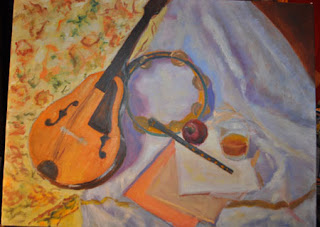Remodeling Part 1
Greetings! I hope that you are safe and in good health.I am like everyone else trying to keep busy, stay productive and remain healthy during this health crisis. All of my classes are on hold and there's no way to tell when they will start again. I know a lot of my students are anxious to get back to class and I do miss my students and teaching.
I am not much of a remote instructor. I enjoy hands on teaching and love the interaction with my students. However, that not being possible right now, I think a lot of you would be interested in how I go about planning and executing a painting.
Most of the time, I start a painting from the beginning with a drawing, canvas prepping, transferring of the design to canvas, and then I spend a few days painting and it's done. Sometimes, though, I revisit a painting that started out okay, but then suddenly stopped dead in its tracks. Usually, I am not happy with the direction it's going and rather then go raging mad and rip the canvas apart like Cezanne often did (though I admit occasionally the thought does occur to me!), I set the painting aside and look at it now and then. I think about how I can modify and improve it. I call it "Remodeling," though I don't use a sledge hammer.
By the way, if you haven't seen the Netflix movie, Cezanne et moi, about the friendship of Paul Cezanne and Emile Zola, I highly recommend it! You can find it on Netflix.
But I digress. I started this painting about three years ago, and was unsatisfied with some parts of it, so I have been pondering over it ever since. I'm now ready to tackle it with a fresh new perspective. I thought that some of you might be interested in how I rework a painting, so I'm going to post the original artwork for this first post, and I'm going to show you how I'm planning to change it. I will send out additional emails that will show the steps that I take and will tell you the reasons for my steps.
Here it is:

The Drawing
The first step is to start with a brand-new drawing. I had some drawing paper that was the exact size of the canvas, which helped. I began working on a new design using a soft pencil and a kneaded eraser. I decided that I liked the mandolin and tambourine, so they will continue to be part of the setup. I liked the colorful fabric because it gave an interesting texture to the design but I didn't care for the white fabric and felt the small objects were lost in the design, so I discarded these. I re-positioned the tambourine and added the guitar, sheet music, and pen. The background will be very dark except toward the bottom where the fabric will be reintroduced.It's important to note that my drawing is not just a line drawing, but also includes the dark and light areas (values) which I believe are critical to the design. If there's a nice balance of contrast, the picture will be more pleasing. This design shows a good mix of light, medium and dark values. The position of the items is also important. The eye should always be "invited" into the picture like a welcome guest and "asked to stay."
In a few days, I'll post the next step in the process. So sit back and relax. I hope you enjoy this free instruction. Perhaps it will inspire you to pick up that brush and paint a masterpiece!
Tip: Measure as you go, check accuracy by turning the canvas upside down and/or use a mirror.
Another Kind of Remodeling
Finally, I managed to get past some of the problems that prevented me from rebuilding my website. I'm happy to say that the new site is up and running. You can now view it from a computer or mobile device. I have a new Art Instruction page and a new Contact page. The dates for instruction and exhibitions are not current since I designed it before the pandemic shut things down, but I will update it when I have good dates.I'm hoping that classes resume in late spring, but if they don't, I will be offering the same classes in painting and drawing this fall at Hamden Adult Ed, and Wallingford Adult Ed. I hope to offer classes this summer at Artsplace and continue with painting classes at the North Haven Senior Center. Stay tuned for updates.





No comments:
Post a Comment